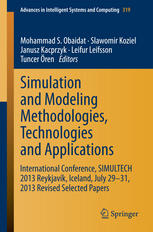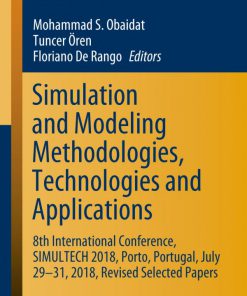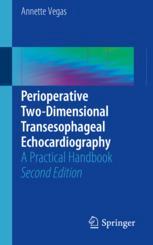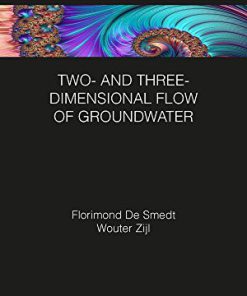Ultrathin Two Dimensional Semiconductors for Novel Electronic Applications 1st Edition by Mohammad Karbalaei Akbari 1000072525 9781000072525
$50.00 Original price was: $50.00.$25.00Current price is: $25.00.
Ultrathin Two-Dimensional Semiconductors for Novel Electronic Applications 1st Edition by Mohammad Karbalaei Akbari – Ebook PDF Instant Download/DeliveryISBN: 1000072525, 9781000072525
Full download Ultrathin Two-Dimensional Semiconductors for Novel Electronic Applications 1st Edition after payment.
![]()
Product details:
ISBN-10 : 1000072525
ISBN-13 : 9781000072525
Author: Mohammad Karbalaei Akbari
Offering perspective on both the scientific and engineering aspects of 2D semiconductors, Ultrathin Two-Dimensional Semiconductors for Novel Electronic Applications discusses how to successfully engineer 2D materials for practical applications. It also covers several novel topics regarding 2D semiconductors which have not yet been discussed in any other publications. Features: Provides comprehensive information and data about wafer-scale deposition of 2D semiconductors, ranging from scientific discussions up to the planning of experiments and reliability testing of the fabricated samples Precisely discusses wafer-scale ALD and CVD of 2D semiconductors and investigates various aspects of deposition techniques Covers the new group of 2D materials synthesized from surface oxide of liquid metals and also explains the device fabrication and post-treatment of these 2D nanostructures Addresses a wide range of scientific and practical applications of 2D semiconductors and electronic and optoelectronic devices based on these nanostructures Offers novel coverage of 2D heterostructures and heterointerfaces and provides practical information about fabrication and application of these heterostructures Introduces the latest advancement in fabrication of novel memristors, artificial synapses and sensorimotor devices based on 2D semiconductors This work offers practical information valuable for engineering applications that will appeal to researchers, academics, and scientists working with and interested in developing an array of semiconductor electronic devices.
Ultrathin Two-Dimensional Semiconductors for Novel Electronic Applications 1st Table of contents:
Chapter 1 Chemical Vapor Deposition of Two-Dimensional Semiconductors
1.1 Overview
1.2 The Key Parameters of CVD Growth of 2D Materials
1.2.1 Precursor
1.2.2 Temperature
1.2.3 Pressure
1.2.4 Substrate
1.2.5 Other Technological Parameters
1.3 The CVD Growth of 2D Materials
1.3.1 Grain Size of 2D Materials
1.3.2 Layer Number of 2D Materials
1.3.3 Orientation
1.3.4 Morphology
1.3.5 Phase
1.3.6 Doping
1.3.7 Quality and Defects
1.4 The Wafer-Scale CVD Growth of Continuous 2D Materials
1.4.1 Continuous CVD Growth of 2D TMDC Films on Rigid Substrates
1.4.1.1 MOCVD
1.4.1.2 Conventional CVD Techniques
1.4.1.3 Other Thin-Film Deposition Method
1.4.2 Continuous CVD Growth of 2D TMDC Films on Flexible Substrates
1.5 The CVD Growth of Heterostructured 2D Materials
1.5.1 CVD Growth of Vertical 2D Heterostructures
1.5.1.1 CVD Growth of Metal/Semiconductor Vertical 2D Heterostructures
1.5.1.2 CVD-Grown Semiconductor/Semiconductor Vertical 2D Heterostructures
1.5.1.3 CVD Growth of Semiconductor/Insulator Vertical 2D Heterostructures
1.5.1.4 CVD Growth of Metal/Insulator Vertical 2D Heterostructures
1.5.2 CVD Growth of Lateral 2D Heterostructures
1.5.2.1 CVD Growth of Semiconductor/Semiconductor Lateral 2D Heterostructures
1.5.2.2 CVD Growth of Metal/Insulator Lateral 2D Heterostructures
1.6 Future Outlook of CVD of 2D Materials
References
Chapter 2 Atomic Layer Deposition of Two-Dimensional Semiconductors
2.1 Overview of ALD Technique of 2D Materials
2.2 ALD Parameters
2.2.1 ALD Window
2.2.2 ALD Precursors
2.3 ALD of 2D Metal Chalcogenide Films
2.3.1 ALD of 2D MoS2
2.3.2 ALD of 2D WS2
2.3.3 ALD of 2D WSe2
2.3.4 ALD of Layered SnS and SnS2 Films
2.3.5 ALD of Layered Metal Dichalcogenide Heterostructures
2.4 ALD of 2D Metal Oxide Films
2.4.1 ALD of 2D MoO3
2.4.2 ALD of 2D WO3
2.4.3 ALD of 2D TiO2
2.4.4 ALD of 2D Al2O3
2.5 Conclusion
References
Chapter 3 Self-Limiting Two-Dimensional Surface Oxides of Liquid Metals
3.1 Introduction
3.2 The Fundamental Properties of Liquid Metals
3.2.1 Monophasic and Biphasic Liquid Metals and Alloys
3.2.2 Characteristics of the Liquid Metal Interface
3.3 Synthesis and Applications of 2D Surface Oxides of Liquid Metals
3.3.1 Screen Printing of 2D Semiconductors
3.3.1.1 Screen Printing of Ga2O3 and GaS 2D Films
3.3.1.2 Wafer-Scale Screen Printing of GaS 2D Films
3.3.2 Reactive Environment for Synthesis of 2D Semiconductor Films
3.3.3 Liquid Metal Media for Green Synthesis of Ultrathin Flux Membranes
3.3.4 The vdW Exfoliation and Printing Methods of 2D Semiconductors
3.3.4.1 Semiconducting SnO Monolayers
3.3.4.2 Semiconducting 2D Gallium Phosphate Nanosheets
3.3.4.3 Semiconducting GaN and InN Nanosheets
3.3.4.4 SnO/In2O3 2D van der Waals Heterostructure
3.3.5 Sonochemical-Assisted Functionalization of Surface Oxide of Galinstan
Conclusions
References
Chapter 4 Hetero-Interfaces in 2D-Based Semiconductor Devices
4.1 Introduction to 2D Hetero-Interfaces
4.2 Properties of 2D Hetero-Interfaces
4.2.1 Band Alignment
4.2.2 Charge Transport in Hetero-Interfaces
4.2.3 Generation of Interlayer Excitons
4.3 The Atomic Structures at Hetero-Interfaces
4.3.1 Homogenous Junctions
4.3.1.1 Structural Properties at Hetero-Interfaces
4.3.1.2 Doping and Passivation
4.3.1.3 Strain and Dielectric Modulation
4.3.2 Heterogeneous Junctions
4.3.2.1 Semiconductor/Semiconductor 2D Hetero-Interfaces
4.3.2.2 Metal/Semiconductor (MS) Heterogeneous Junctions
4.3.3 Electrical Contact at 2D Semiconductors
4.3.3.1 The Geometry of Interfaces
4.3.3.2 The Charge-Injection Mechanism
4.4 Devices Based on Heterostructured 2D Films
4.4.1 Electronic Devices Based on Heterostructured 2D Films
4.4.2 Magnetic Devices Based on 2D Heterostructured Materials
4.4.3 Spintronic and Valleytronic 2D Heterostructured Devices
Conclusion
References
Chapter 5 Photonic and Plasmonic Devices Based on Two-Dimensional Semiconductors
5.1 Introduction
5.2 Plasmonic 2D Nanostructures
5.2.1 Principles
5.3 Plasmonic Phenomena in Graphene
5.3.1 Structural Design of 2D Graphene for Plasmonic Tuning
5.3.2 Plasmonic Tuning of Hybrid 2D Graphene-Based Devices
5.4 Plasmonic Phenomenon in 2D Materials beyond the Graphene
5.4.1 Plasmon Tuning by Doping of 2D Materials beyond the Graphene
5.4.1.1 Doping of 2D MoS2
5.4.1.2 Surface Functionalization of 2D Surface Oxide of Galinstan Alloy
5.5 Fabrication of Nanostructured Arrays for Hybrid Plasmonic Devices
5.6 Application of Plasmonic Devices Based on Ultrathin 2D Materials
5.6.1 Plasmonic Two-Dimensional Au-WO3-TiO2 Heterojunction
5.6.2 Plasmonic-Assisted 2D Photodetector Devices
Conclusions
References
Chapter 6 Memristive Devices Based on Ultrathin 2D Materials
6.1 Introduction to Memristor Characteristics
6.2 Solid States Electronics of Resistive Switching
6.2.1 The Missing Memristor
6.2.2 Memristive Materials and Their RS Mechanisms
6.2.2.1 Anion-Based Memristors and Their RS Mechanisms
6.2.2.2 Cation-Based Memristors and Their RS Mechanisms
6.3 Fabrication of Memristor Devices Based on 2D Materials
6.3.1 Device Structure
6.3.1.1 Vertical Memristors
6.3.1.2 Lateral Memristors
6.3.1.3 Tip-Based Memristors
6.3.2 Atomic-Layered 2D Materials for Memristor Devices
6.3.3 Fabrication Techniques of 2D Materials for Memristors
6.3.4 Electrodes for 2D-Based Memristor Devices
6.4 Electrical-Pulse-Triggered Memristor Devices Based on Ultrathin 2D Materials
6.4.1 Complementary Resistive Switching (CRS) in TaOx, HfOx, and TiOx Devices
6.4.2 CRS in Heterostructured Memristor Devices
6.4.3 RS Phenomenon in TiO2 Thin Films
6.4.3.1 Filamentary RS in TiO2 Ultrathin Film
6.4.3.2 Complementary RS in In-Doped TiO2 Ultrathin Film
6.4.3.3 Bipolar RS in Pt/TiO2/Ti/Pt 2D Memristors
6.4.4 RS in Exfoliated 2D Perovskite Single Crystal
6.4.5 Memristor Devices Based on 2D MoS2
6.4.5.1 Memristor Device Based on Oxidized MoS2 Nanosheets
6.4.5.2 Memristor Device Based on CVD MoS2 2D Film
6.4.5.3 2D MoS2 Memristor for Efficient-Energy Radio Frequency
6.4.6 Memristor Devices Based on 2D MoS2, MoSe2, WS2, and WSe2
6.4.7 Memristor Devices Based on 2D Insulating h-BN
6.5 Optoelectronic Memristor Devices Based on Ultrathin 2D Materials
6.5.1 Nonvolatile Optical Resistive Memories versus Optical Sensors
6.5.2 Case Study of Optical Memristor Devices
6.5.2.1 Optical Memories Based on 2D MoS2
6.5.2.2 Heterostructured 2D-Based Nonvolatile Optical Memory Devices
Conclusion
References
Chapter 7 Artificial Synaptic Devices Based on Two-Dimensional Semiconductors
7.1 Introduction to Artificial Synaptic Functionalities
7.1.1 Challenges of Data Processing
7.1.2 Biological Synapse versus the Artificial Synapse
7.1.2.1 Biological Synapse
7.1.2.2 Artificial Synapse
7.2 Synaptic Electronics Based on 2D Materials
7.2.1 Design and Structure of Devices
7.2.2 Electronic/Ionic Artificial Synapses
7.2.2.1 Polycrystalline 2D MoS2 Synaptic Device
7.2.2.2 Electro-Iono-Photoactive 2D MoS2 Synaptic Device
7.2.2.3 Ionic Transport in 2D Perovskite Synaptic Devices
7.2.2.4 In-Ion Doped Ultrathin TiO2 Optical Synaptic Devices
7.2.3 Electrochemical Metallization/Conductive Bridge (ECM/CB) Artificial Synapses
7.2.4 Redox/Valence Changing Artificial Synapses
7.2.4.1 Proton Intercalated Quasi-2D α-MoO2 Artificial Synaptic Transistor
7.2.4.2 Li-Ions Intercalated Quasi-2D α-MoO2 Artificial Synaptic Transistor
7.2.5 Phase-Change Synapses
7.2.6 Thermochemical/Joule Heating Synapses
7.2.7 2D Heterostructured-Based Synapses
7.2.8 Optical-Based Synapses
7.2.8.1 Optical Synaptic Devices versus Photodetectors
7.2.8.2 Optical RRAM Synaptic Devices
7.3 Conclusions
References
Chapter 8 Sensorimotor Devices Based on Two-Dimensional Semiconductor Materials
8.1 Introduction to Bioinspired Sensorimotor Devices
8.2 Optoelectronic Devices
8.2.1 Sensorimotor Device Based on Ultrathin TiO2 Film
8.2.1.1 Working Mechanism of Sensorimotors
8.2.1.2 Ion Intercalation for Visible Light Sensitivity
8.2.1.3 The Sensorimotor System
8.2.2 Optic-Neural Synaptic Device Based on h-BN/WSe2 2D Heterostructure
8.2.3 Ultrathin ZnO Photodetectors for Stretchable Sensorimotors
8.3 Ultrathin Oxide Films Nociceptor Devices
8.3.1 Artificial Nociceptors Based on 2D SiO2 Diffusive Memristors
8.3.2 Thermal Nociceptor Based on 2D SiO2 Diffusive Memristors
8.3.3 Artificial Nociceptors Based on Ultrathin HfO2 Memristors
People also search for Ultrathin Two-Dimensional Semiconductors for Novel Electronic Applications 1st:
ultrathin solar cells
ultrathin two-dimensional nanomaterials
ultrathin two-dimensional superconductivity with strong spin–orbit coupling
2d semiconductor materials
a semiconductor is
Tags: Ultrathin, Two Dimensional, Semiconductors, Electronic Applications, Mohammad Karbalaei Akbari
You may also like…
Computers - Computer Science











